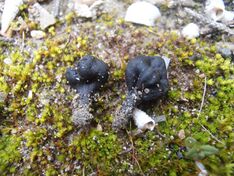Biology:Geoglossum dunense
| Geoglossum dunense | |
|---|---|

| |
| Scientific classification | |
| Kingdom: | |
| Division: | |
| Class: | Geoglossomycetes
|
| Order: | |
| Family: | |
| Genus: | |
| Species: | G. dunense
|
| Binomial name | |
| Geoglossum dunense Loizides, M.Carbone & P.Alvarado (2015)
| |
Geoglossum dunense is an earth tongue fungus in the family Geoglossaceae, described as new to science in 2015. It is known from the island of Cyprus, where it grows in coastal dunes and salt marshes under the Phoenicean juniper (Juniperus phoenicea), but has also been documented in Malta and England following collections from diverse habitats. It produces very small fruit bodies barely exceeding 1–2 cm and has polymorphic, often moniliform paraphyses and predominantly 3-septate spores.
Taxonomy and phylogeny
Geoglossum dunense was described as new to science in 2015, following collections from the Mediterranean islands of Cyprus and Malta. Phylogenetic analyses of the ribosomal internal transcribed spacer (ITS) region and large subunit ribosomal ribonucleic acid (LSU), have placed G. dunense in an independent lineage near G. vleugelianum and G. inflatum.[1]
Description
Morphology
The tiny fruitbodies, measuring 1−2.3 cm by 0.8−1.1 cm, are black, dry, and consist of a lobed or club-shaped head and a minutely squamulose stipe which is usually submerged into the substrate.
The spores are fusiform to subfusiform, somewhat bent, measuring (28−) 31−44 (−53) by (7−) 8−10 (−12) μm. At maturity they develop 2−3, or very rarely 1−4 septa. The paraphyses are highly polymorphic and often moniliform, hooked, branched, or contorted. The asci are large, 8-spored and have an amyloid apical pore. The trama features parallel or sometimes intertwined hyphae, resembling a textura intricata. The stipe surface is composed of brown hyphae with short, slightly clavate terminal elements 4–6 μm wide.[1][2]
Similar species
A very similar species to Geoglossum dunense is G. heuflerianum, originally collected from Nockspitze mountain, south-east of Innsbruck, Austria.[3] This poorly known taxon was rediscovered in 2017 after more than 150 years, and an updated description was provided by Fluri and colleagues.[4] It differs from G. dunense mainly in its alpine ecology, slightly smaller fruit bodies up to 1.4 cm tall and slightly larger spores measuring 38.7–52.7 × 8.3–11.3 μm.
Geoglossum hakelieri, described from grassy pastures in Sweden, is also reported to have multiseptate polymorphic paraphyses and spores with 1–3(−5) septa, but produces much larger brownish-grey ascocarps up to 4–5 cm tall, has more slender cylindrical spores measuring 30–40 × 4.5–5.5 μm, and much smaller asci measuring 100–125 × 12–17 μm.[5][6]
Ecology and distribution
On Cyprus and Malta, Geoglossum dunense grows on coastal dunes and salt marshes among Juniperus, Olea and Fumana shrubs.[1][2] A 2019 British report of this species from grasslands in Hardcastle Crags (West Yorkshire), however, suggests that its ecology and distribution might be wider than previously thought.[7]
References
- ↑ 1.0 1.1 1.2 "Geoglossum dunense (Ascomycota, Geoglossales): a new species from the Mediterranean islands of Cyprus and Malta". Mycological Progress 14 (6): 41. 2015. doi:10.1007/s11557-015-1064-9.
- ↑ 2.0 2.1 "Additions to the mycobiota of the Maltese islands: Pezizomycotina. First part.". Micologia e Vegetazione Mediterranea 30 (2): 75–96. 2016.
- ↑ "Das Pilztypenherbar, im Auftrage des kaiserlich-österreichischen Ministeriums für Cultus und Unterricht". Österreichische Botanische Zeitschrift 10: 101–114. 1860.
- ↑ "Geoglossum heuflerianum – Wiederentdeckung einer alpinen Art in der Schweiz". Österreichische Zeitschrift für Pilzkunde 26: 87–97. 2017.
- ↑ "Three new Swedish species of Geoglossum". Svensk Botanisk Tidskrift 61: 419–424. 1967.
- ↑ "Geoglossum hakelieri, ett nytt namn för G. fumosum Hakelier.". Windahlia 12 (13): 81–88. 1983.
- ↑ "An assessment of the fungal conservation value of Hardcastle Crags (Hebden Bridge, West Yorkshire) using NextGen DNA sequencing of soil samples.". Natural England Commissioned Reports 258: 1–37. 2019.
External links
Wikidata ☰ Q20817828 entry
 |



